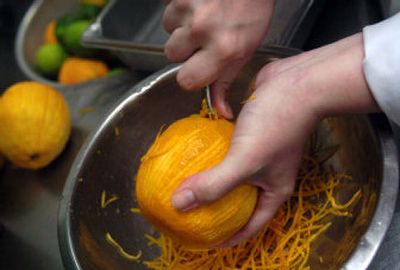Lessons at WSU are tasteful

PULLMAN – The final exam was multiple choice, with a multitude of choices.
Saute or steam? Dice or julienne? Mash or roast?
The students in Chef Gene Fritz’s class were given three ingredients and two hours Friday to plan and produce an elegant lunch – kind of like “Iron Chef” without all the TV cameras and sea urchin.
They were part of a weeklong conference at Washington State University for high school teachers who prepare students for careers in the hospitality industry. The lessons spanned knifework, food safety, cooking techniques and fancy French culinary talk – from mise en place to monte au beurre.
“The students get to eat what they learn,” said Fritz, a chef and instructor in the school’s Hospitality Business Management program. “It doesn’t get any better than that.”
The course, which is part of a restaurant-industry sponsored program called ProStart, included visits to restaurants around the region, classes in cooking techniques and hands-on practice in the restaurant-style kitchen at WSU’s Todd Hall. Twenty-eight teachers from seven Western states participated.
They’ll return to their schools and help prepare high schoolers for careers or further education in the restaurant and food service industry, which is adding about 300,000 jobs a year nationwide, according to ProStart. Teachers say there’s a lot of interest among students in cooking right now.
“The teens really like the Food Network,” said Becky Wilson, who will teach at a new high school in Bonney Lake, Wash. “They want to be the next Alton Brown or Rachael Ray” – two cooking-show stars.
Of course, TV cooking stars represent a fairly small portion of those who earn their living in the kitchen. And the chaos of a professional kitchen doesn’t look much like the televised calm of those shows.
During Friday’s final “Capstone Mystery Basket” event, teams of four were each given one meat, one vegetable and one starch – and two hours to turn it into a professionally presented meal.
Sauces bubbled on the stove. Students in chef’s coats and hats dodged back and forth with ingredients and pans. Oranges were zested and asparagus blanched.
Fritz prowled the kitchen, giving advice and hollering encouragement and instructions.
“Team One, you’re at 13 minutes,” he said, then added for everyone. “Make sure you think about cleanup. Cleanup, cleanup. Clean as you go.”
When flames leapt from a pan in an unintentional flambé, he shouted, “Pyro!”
Another team, breading halibut in potato chips and parmesan cheese, drew loud praise from Fritz.
“Tim’s Chips!” he hollered. “Breading that with Tim’s Chips. I love it!”
Team Five was made up of educators from around the West – Elaine Reynolds from Quincy High School, Debbie Greene from Kamiakin High in Kennewick, Mary Rhodes from New Mexico and Sharon Farquhar from Wyoming.
For their menu, Fritz gave them chicken legs, brown rice and asparagus. An early question arose: To bone or not to bone the chicken legs?
“I don’t particularly want to bone,” Greene said.
The group decided against boning. They would grill the lemon-marinated chicken and serve it with rice pilaf and cold asparagus wrapped in prosciutto, provolone and red bell pepper. Fritz gave their menu a quick look and offered some advice.
“Raspberry or a vinaigrette – that’d be something I’d want to hear on that menu,” he said. “You want a pop. When I read grilled chicken, rice pilaf and wrapped asparagus – it’s general. I’m looking for more specificity.”
At the end of two hours, he looked over the plates and critiqued each offering, emphasizing different ways to “plate” the food. In most cases, he took plates where each food had a spot and brought them together, creating vertical lean-tos of protein and starch.
“You want for the food to be not compartmentalized,” he told one group.
When he returned to Team Five, they had asparagus wrapped in prosciutto and provolone sitting beside a mound of rice pilaf with crossed drumsticks.
“The asparagus looks awesome,” Fritz said, “but right now it’s a hot plate with cold asparagus. I’d be looking for a hot plate with hot asparagus.”
This was WSU’s fourth year running the program, Fritz said. Many of the students said it was the best educational conference they’d ever attended – largely because of all the activity and hands-on work. Fritz said that’s the key to giving the teachers enough knowledge to pass it on.
“I mean, listen to that searing,” Fritz said, sitting in the banquet room outside the kitchen earlier this week. “Right now they’re standing back there, and they’re doing it.”